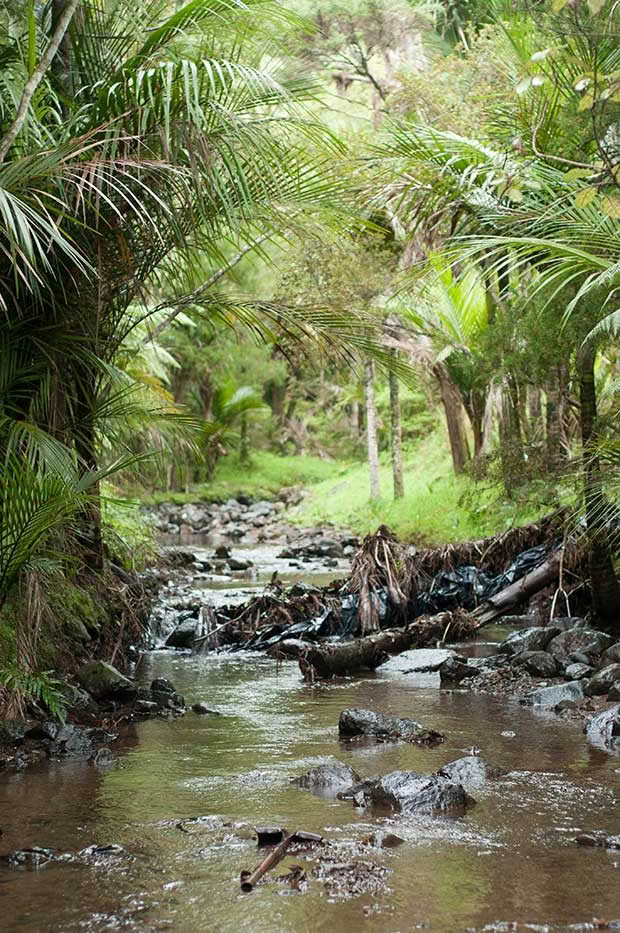Andy Ellis’ tips for growing native New Zealand plants in your backyard

Before Andy Ellis was an All Black he was, in his own words, a “pimply-faced landscape architecture student at Lincoln University”. He put his degree on hold to play professional rugby, but did gardening work on the side, and even competed in the Ellerslie International Flower Show and Singapore Garden Festival. Eleven years later, he’s hung up his All Blacks shirt (and the degree is still on hold) but his passion for gardening remains as strong as ever.
In this exclusive extract from his new book Kiwi Backyard, Andy suggests ways to create a “native haven” in your garden.

GROW YOUR OWN NATIVE PLANTS
Many indigenous plants, from tī kōuka (cabbage trees) to tītoki, can be raised successfully—and cheaply— from seed collected from friends’ gardens or (if you seek permission or a Department of Conservation permit first) public areas of native planting or bush. The beauty of eco-sourcing seeds from your own neck of the woods is that you can be sure they’ll grow well in your local climate.
✿ Most native seeds ripen from late summer into autumn and are best sown fresh for peak germination viability. Scatter and rake in the seed directly where you want your native garden to grow, or start seeds off in trays of seed-raising mix (from garden centres), then transplant or grow as seedlings when they are bigger.
✿ Some seeds, such as kōwhai, have a hard, inhibitive shell that needs nicking with a pocket knife prior to
sowing. Others have soft berries, such as karaka and pūriri, which need the outer layer of flesh cleaned off first.
✿ Tussock grasses, libertias and phormiums will self-sow, but you can also use a sharp spade to chop up established clumps every few years to increase their numbers.

The flax-like kakaha grows well in pots or beds and is ideal for mass planting.
PLANTING IDEAS FOR A NATIVE HAVEN
Piripiri • Acaena caesiiglauca
This eerily silver ground cover has small foliage and a carpeting habit, making it an attractive option for snuggling between paving stones as a living grout. Eliminate all
perennial weeds prior to planting.
Piripiri is robust in exposed coastal gardens, but is no fan of humidity.
Purple piripiri • Acaena inermis ‘Purpurea’
A darling of Kiwi landscape architects, this burgundy-foliaged bidibid keeps its head down and spreads its wings into nooks and crannies in rockeries or between paving stones. Its colour is best in full sun in fertile but gritty soil, so feed with slow release fertiliser.
Gossamer grass • Anemanthele lessoniana
Also known as Oryzopsis lessoniana, this topnotch native grass has a graceful weeping habit. Takes dry shade or full sun; in the former it stays green, but out in the open the foliage turns coppery bronze by midsummer.
Ethereal flowers shimmer over the whole plant in spring. Grows to 1 metre.
Oioi (jointed rush) • Apodasmia similis, Leptocarpus similis
This popular New Zealand native reed does well in soggy or dry spots and looks best mass-planted in sweeps or rows. Suits coastal and wetland conditions. Grows to 1 metre.
Shining spleenwort • Asplenium oblongifolium
This groovy deep-green forest fern is an endemic beauty commonly seen in the South Island. Sends out handsome, shiny green fronds up to 1 metre long. Relishes the shade under specimen trees. Keep well-watered until it finds its feet; after that it can cope with considerable drought.
Kakaha • Astelia fragrans
The green flax-like cousin of the dramatic native silver spear. Strappy foliage with fragrant flower spikes in spring. Does best in light shade and won’t tolerate humidity. Plant in pots or beds. Grows to 1 metre.
Kiokio • Blechnum novae-zelandiae
Endemic to New Zealand, this cape fern has eye-catching salmon-pink new fronds that mature to dark green. A tough cascading fern that develops red tones in sun. Grows to 1 metre.

The purple piripiri is a favourite of landscape architects thanks to its striking colour.
Tī kōuka (cabbage tree) • Cordyline australis
With its striking silhouette, the cabbage tree is an iconic choice for any Kiwi landscape, large or small. Evergreen, hardy and tolerant of wet and dry soils, it feeds the birds and the bees, and its young heart is pretty tasty in a hāngī! Eventually forms multi-trunked clumps. Grows to 6 metres.
Shore spurge • Euphorbia glauca
A coastal stunner with succulent foliage in silvery green or blue, this native euphorbia deserves to be more widely grown. It likes to live hard—full sun and sandy soil suits it best—and can still be seen growing wild in our sand dunes. Watch out for its milky sap, as it can cause severe skin irritations. Grows to 1 metre.
Kāpuka (broadleaf) • Griselinia littoralis ‘Broadway mint’
An upright shrub with deep-green foliage, this is one of the best forms of griselinia for instant hedging or shelter in a hurry.
Space 1 metre apart and clip twice a year. Tough, hardy and drought-tolerant once established. Clip at any height from 1–2.5 metres.
South Island koromiko • Hebe salicifolia
A medicinal native herb traditionally used to treat everything from skin complaints to upset stomachs. Shrubby in form with narrow spear-shaped leaves and pointy white hebe flowers. Grows to 2 metres.
Mīkoikoi (New Zealand iris) • Libertia ixioides
Unlike flamboyant bearded irises, our indigenous version is grown more for its structural foliage than its diminutive flowers, which hide between its strappy blades. When the foliage gets untidy, prune back hard to just above ground level. Grows to 30 centimetres.
Puka • Meryta sinclairii
Possibly our most tropical-looking native tree, with a Dr. Seuss-like head of huge green paddle-shaped leaves. Fast-growing, but easily brought back down to size if need be as mature trunks naturally branch. Frost can knock the tops off, but wet feet is its worst enemy. Grows to 6 metres.
Dwarf flax • Phormium ‘Green dwarf’
An upright dwarf flax with yellow flowers that bring in the birds and bees. Ideal for mass-planting in small gardens. Grows to 75 centimetres.
Kōhūhū • Pittosporum tenuifolium
Like most pittos, this species hits the ground running and grows rapidly, with characteristic silvery-green foliage and night-scented, nectar-rich dark-purple flowers. In the wild, kōhūhū can reach 10 metres tall and it doesn’t take kindly to being pruned to size; the variety ‘Mountain Green’ is more compact with vibrant green foliage. Grows to 4 metres.
Puahou (New Zealand five finger) • Pseudopanax arboreus
Quick to grow, this large shrub or small tree has distinctive, glossy five-fingered (or sometimes seven-fingered) leaves, hence its common name. Unfussy in most situations, with architectural flowers followed by dark purple berries. Grows to 3 metres.
Horoeka (lancewood) • Pseudopanax crassifolius
This slender native tree has a distinctive juvenile form, with prehistoric-looking pointy, leathery leaves, before it undergoes a teenage transformation into a sturdy specimen tree after 10 to 15 years. Grows to 5 metres.

Kiwi Backyard
By Andy Ellis
RRP $45 buy online here
Extract courtesy of Allen & Unwin NZ

